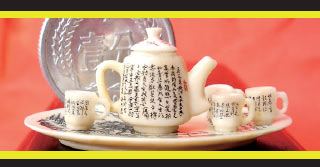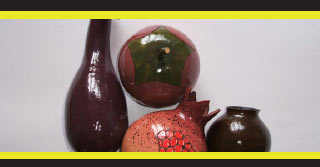|
 Nie Chenxi |
Niejiazhuang Clay Figurines
15 / 11 ~ 04 / 12
2011
The art of Gaomi Niejiazhuang Clay Figurines reached its
zenith during the reign of Emperor Jiaqing (1796-1820), in the Qing
Dynasty. Then, gradually, the figurines adopted a dynamic rather
than static mode, depicting motion and sound, often comically.
The clay figurines produced in Niejiazhuang Village are generally
painted in bold colours with exaggerated, coarse features, striving
for spiritual resonance rather than strict resemblance. The shapes
have a charming simplicity and innocence, and many examples
are both static and dynamic, qualities that set them apart among
China’s clay figurine traditions, earning the art a place in the
National Intangible Cultural Heritage.
A representative heir of the Niejiazhuang clay figurine art,
Nie Chenxi excels at shaping all types of animals and human
figures. His primary style is known as the ‘roaring tiger clay
figurine’, which is not only a traditional child’s plaything but also
an auspicious mascot that protects the home with its imposing
shape and bright colours. |
| |
|
 Kong Nannan |
Confucian Kai Wood Carving
15 / 11 ~ 04 / 12
2011
The Kai Wood Carving tradition of Qufu City dates back over
2,400 years. Qufu’s Confucian Forest, famous for its rare kai trees,
supplied the raw material when the Confucian disciple Zi Gong
sought to memorialise his master in wooden statues. This act
became a tradition, passed down through the hands of a great host
of artisans, gradually becoming an art form with its own distinctive
carving style. Traditional shapes include images of Confucius,
walking sticks and the ceremonial curved sceptre known as ‘ruyi’.
Kong Nannan is a 74th generation descendant of Confucius
in Qufu City, Shandong, and the sixth direct-line inheritor of the
Qufu Confucian Kai Wood Carving tradition inscribed on China’s
list of National Intangible Cultural Heritage. His works are refined
and delicately carved with an elaborate and balanced composition.
Kong seeks fine, vivid, beautiful and elegant artistic qualities to
capture the immensely rich folk characteristics of his subjects. |
| |
|
 Sun Xiulan |
Weifang Cloth Toys
06 ~ 25 / 12
2011
Weifang Cloth Toys come in a wide variety of forms, all
fashioned with refined skill. Made of materials such as coloured
silk, satin, flannel, fur, coloured strings, threads of gold and silver
and beads, their production requires complex and intricate sewing
techniques. The majority of toys are themed on animals and employ
highly exaggerated shapes to depict rich folk culture and distinctive
regional characteristics.
Sun Xiulan is a first-rank folk art master in Weifang and a
successor of Weifang’s Intangible Cultural Heritage. Beginning at
an early age, Sun excelled in designing and producing cloth toys
possessing novel design, concise shapes, moderate exaggeration
and sharp colours. Her cloth toys are widely favoured both at home
and abroad. |
| |
|
 Lu Ning |
Zibo Interior Surface Painting
06 ~ 25 / 12
2011
Zibo Interior Surface Painting enjoys a high reputation
throughout the country. Using special brushes, artisans paint
a detailed reversed image on the inside of bottles, through an
opening as small as a bean. Such polished and peculiar skills rely
heavily on the eyesight, patience and brushwork of the painters,
who bring this art to the zenith of perfection.
Beginning at the age of thirteen, Lu Ning studied traditional
Chinese arts and crafts and the skill of interior surface painting
under master Zhang Guangqing. For twenty years she dedicated
herself to the study of this art, inventing novel compositions for
her delicate, elegant paintings. Her works reveal a smooth use of
the brush, standing apart from other interior surface paintings.
She has won several important national awards, and her works are
displayed in museums both at home and abroad. |
| |
|
 Zhang Jian |
Linqu Red Silk Inkstones
27/ 12 ~ 15 / 01
2011 2012
Red Silk Inkstones, named for Linqu County (or sometimes
Qingzhou City), were considered the finest of the four famous
inkstones of the Tang and Song Dynasties (618-1279), owing to
their fine, gentle texture, vivid, bright coloration and diversity of
pattern. The authors Wang Anshi, Ouyang Xiu and Su Dongpo all
wrote with red silk inkstones and praised them highly.
An artisan of Shandong’s arts and crafts, Zhang Jian began to
collect and study unusual stones, becoming interested in inkstones,
in the mid-80s. Currently, he is engaged in the post-production of
red silk inkstones, as well as that of various kinds of Lu inkstones.
His works have won several accreditations and are both eminently
practical and highly collectible. |
| |
|
 Wang Xianli |
Dezhou Black Pottery
27/ 12 ~ 15 / 01
2011 2012
Dezhou has a long tradition of producing pottery, the black
variety of which enjoys high prestige. Black pottery is an unglazed
ceramic originating in the 6,000-year-old Longshan culture.
Today, Dezhou’s Black Pottery retains these rich and ancient folk
characteristics in its craftsmanship, design and colour. The craft has
also contributed significantly to the overall revival of traditional
ceramics.
As Vice Chairman of the Chinese Black Pottery Arts
Committee, Wang Xianli has conducted research on black pottery
for more than twenty years. Founded by Wang Xianli, the Dezhou
Xianli Black Pottery Research Centre is accomplished in several
areas of research and has received national patents. The Centre’s
research papers and art works have won several prizes, including a
Silver Medal at the International Technological Expo in Paris and a
Gold Medal in the First Chinese Black Pottery Exhibition. |
| |
|
 Wang Tianming
|
Micro Carving
17 / 01 ~ 05 / 02
2011
Micro-carving is a challenging and extremely demanding art.
It continues to play a crucial role in flourishing traditional Chinese
art circles, reflecting the charm, skill and virtuosity inherent in the
nation’s culture.
Engaged in the carving arts for some thirty years, Wang
Tianming is able to carve words just 0.02 mm2 in size. His microcarving
works, such as his bean carvings, are renowned for their
supreme delicacy. Wang is also concerned with his own artistic
cultivation and places particular emphasis on deepening his literary
roots. He has exhibited works and given live demonstrations in
countries worldwide including Germany, France, Switzerland,
Finland, Sweden, Norway, Denmark, Singapore and Korea and
has won several awards both nationally and internationally,
among them a Special Award, Gold Medal and Silver Medal in the
International Arts and Crafts Competition and the National Arts and
Crafts Competition. |
| |
|
 Li Zezhi |
Laixi Gourd
Carving
17 / 01 ~ 05 / 02
2011
Originating in the Ming Dynasty (1368-1644), Laixi Gourd
Carving reached its height in the Qing Dynasty (1644-1911) and
underwent further development in the mid-20th century. It is
an art that has been handed down generation to generation for
more than 400 years. What makes Laixi Gourd Carving special
and influential is the lace-like technique known as the ‘openwork
pattern’. With its well-defined characteristics and distinctive style,
this art was inscribed in the first batch of the Municipal-level
Intangible Cultural Heritage of Qingdao.
The recipient of various awards, Li Zezhi is primarily
engaged in the artistic production of folk gourds and clay
figurines. He excels at producing Laixi Gourd Carvings with
various themes, including traditional auspicious connotations,
historical stories, myths and legends. |
BACK |







